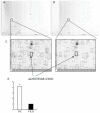Label-free proteomics reveals decreased expression of CD18 and AKNA in peripheral CD4+ T cells from patients with Vogt-Koyanagi-Harada syndrome
- PMID: 21297967
- PMCID: PMC3030555
- DOI: 10.1371/journal.pone.0014616
Label-free proteomics reveals decreased expression of CD18 and AKNA in peripheral CD4+ T cells from patients with Vogt-Koyanagi-Harada syndrome
Erratum in
- PLoS One. 2011;6(3). doi: 10.1371/annotation/2c8e3e74-556c-4e42-a5df-0b8ce294119f
Abstract
Vogt-Koyanagi-Harada (VKH) syndrome is a systemic autoimmune disease. CD4(+) T cells have been shown to be involved in autoimmune diseases including VKH syndrome. To screen aberrantly expressed membrane proteins in CD4(+) T cell from patients with active VKH syndrome, blood samples were taken from five patients with active VKH syndrome and five healthy individuals. A label-free quantitative proteomic strategy was used to identify the differently expressed proteins between the two groups. The results revealed that the expression of 102 peptides was significantly altered (p<0.05) between two groups and matched amino acid sequences of proteins deposited in the international protein index (ipi.HUMAN.v3.36.fasta). The identified peptides corresponded to 64 proteins, in which 30 showed more than a 1.5-fold difference between the two groups. The decreased expression of CD18 and AKNA transcription factor (AKNA), both being three-fold lower than controls in expression identified by the label-free method, was further confirmed in an additional group of five active VKH patients and six normal individuals using the Western blot technique. A significantly decreased expression of CD18 and AKNA suggests a role for both proteins in the pathogenesis of this syndrome.
Conflict of interest statement
Figures



References
-
- Sigle KJ, McLellan GJ, Haynes JS, Myers RK, Betts DM. Unilateral uveitis in a dog with uveodermatologic syndrome. J Am Vet Med Assoc. 2006;228:543–548. - PubMed
-
- Read RW, Holland GN, Rao NA, Tabbara KF, Ohno S, et al. Revised diagnostic criteria for Vogt-Koyanagi-Harada disease: report of an international committee on nomenclature. Am J Ophthalmol. 2001;131:647–652. - PubMed
-
- Yamaki K, Gocho K, Sakuragi S. Pathogenesis of Vogt-Koyanagi-Harada disease. Int Ophthalmol Clin. 2002;42:13–23. - PubMed
-
- Yamaki K, Kondo I, Nakamura H, Miyano M, Konno S, et al. Ocular and extraocular inflammation induced by immunization of tyrosinase related protein 1 and 2 in Lewis rats. Exp Eye Res. 2000;71:361–369. - PubMed
-
- Yang P, Chen L, Zhou H, Zhong H, Wang H, et al. Resistance of lymphocytes to Fas-mediated apoptosis in Behcet's disease and Vogt-Koyangi-Harada syndrome. Ocul Immunol Inflamm. 2002;10:47–52. - PubMed
Publication types
MeSH terms
Substances
LinkOut - more resources
Full Text Sources
Research Materials

